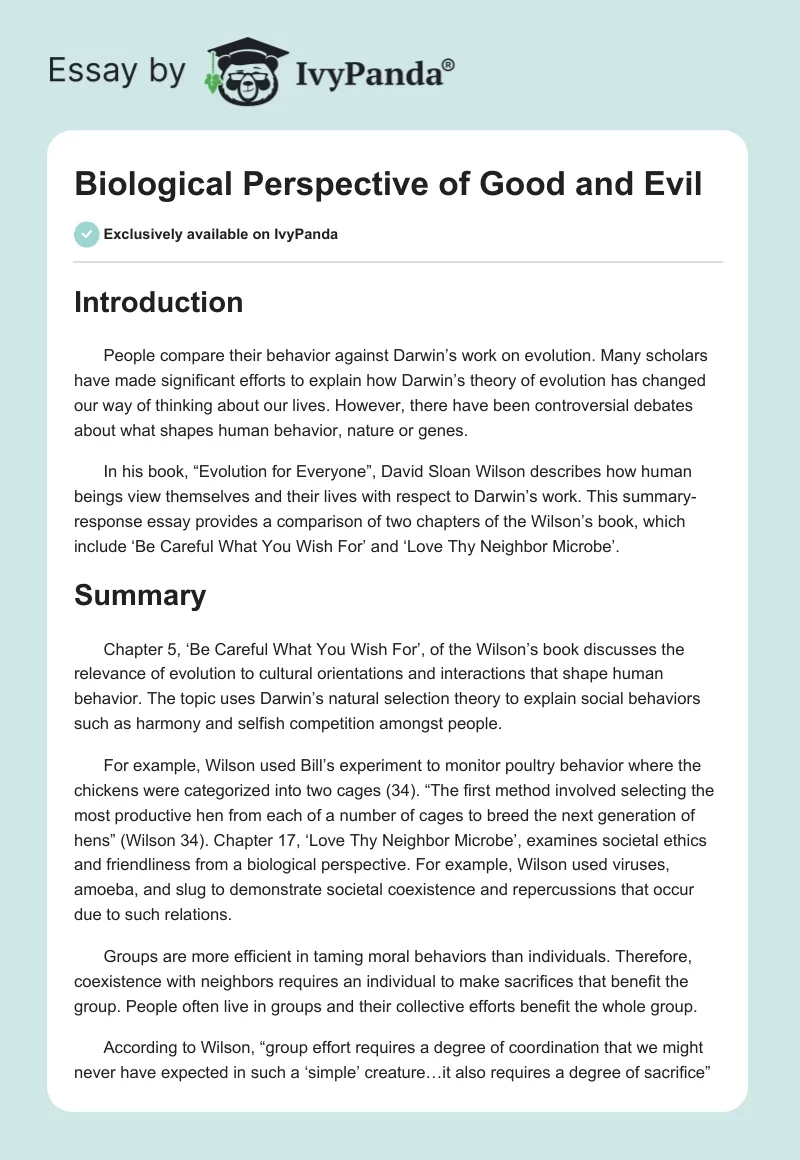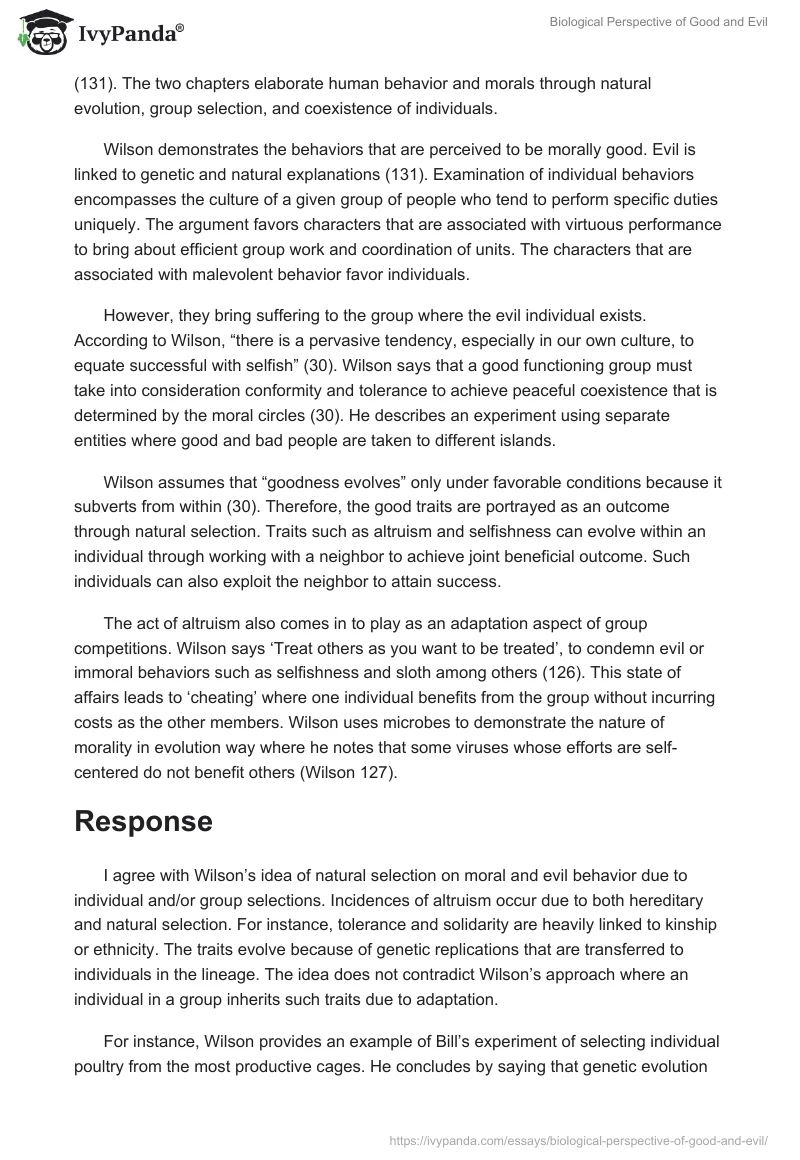Introduction
People compare their behavior against Darwin’s work on evolution. Many scholars have made significant efforts to explain how Darwin’s theory of evolution has changed our way of thinking about our lives. However, there have been controversial debates about what shapes human behavior, nature or genes.
In his book, “Evolution for Everyone”, David Sloan Wilson describes how human beings view themselves and their lives with respect to Darwin’s work. This summary-response essay provides a comparison of two chapters of the Wilson’s book, which include ‘Be Careful What You Wish For’ and ‘Love Thy Neighbor Microbe’.
Summary
Chapter 5, ‘Be Careful What You Wish For’, of the Wilson’s book discusses the relevance of evolution to cultural orientations and interactions that shape human behavior. The topic uses Darwin’s natural selection theory to explain social behaviors such as harmony and selfish competition amongst people.
For example, Wilson used Bill’s experiment to monitor poultry behavior where the chickens were categorized into two cages (34). “The first method involved selecting the most productive hen from each of a number of cages to breed the next generation of hens” (Wilson 34). Chapter 17, ‘Love Thy Neighbor Microbe’, examines societal ethics and friendliness from a biological perspective. For example, Wilson used viruses, amoeba, and slug to demonstrate societal coexistence and repercussions that occur due to such relations.
Groups are more efficient in taming moral behaviors than individuals. Therefore, coexistence with neighbors requires an individual to make sacrifices that benefit the group. People often live in groups and their collective efforts benefit the whole group.
According to Wilson, “group effort requires a degree of coordination that we might never have expected in such a ‘simple’ creature…it also requires a degree of sacrifice” (131). The two chapters elaborate human behavior and morals through natural evolution, group selection, and coexistence of individuals.
Wilson demonstrates the behaviors that are perceived to be morally good. Evil is linked to genetic and natural explanations (131). Examination of individual behaviors encompasses the culture of a given group of people who tend to perform specific duties uniquely. The argument favors characters that are associated with virtuous performance to bring about efficient group work and coordination of units. The characters that are associated with malevolent behavior favor individuals.
However, they bring suffering to the group where the evil individual exists. According to Wilson, “there is a pervasive tendency, especially in our own culture, to equate successful with selfish” (30). Wilson says that a good functioning group must take into consideration conformity and tolerance to achieve peaceful coexistence that is determined by the moral circles (30). He describes an experiment using separate entities where good and bad people are taken to different islands.
Wilson assumes that “goodness evolves” only under favorable conditions because it subverts from within (30). Therefore, the good traits are portrayed as an outcome through natural selection. Traits such as altruism and selfishness can evolve within an individual through working with a neighbor to achieve joint beneficial outcome. Such individuals can also exploit the neighbor to attain success.
The act of altruism also comes in to play as an adaptation aspect of group competitions. Wilson says ‘Treat others as you want to be treated’, to condemn evil or immoral behaviors such as selfishness and sloth among others (126). This state of affairs leads to ‘cheating’ where one individual benefits from the group without incurring costs as the other members. Wilson uses microbes to demonstrate the nature of morality in evolution way where he notes that some viruses whose efforts are self-centered do not benefit others (Wilson 127).
Response
I agree with Wilson’s idea of natural selection on moral and evil behavior due to individual and/or group selections. Incidences of altruism occur due to both hereditary and natural selection. For instance, tolerance and solidarity are heavily linked to kinship or ethnicity. The traits evolve because of genetic replications that are transferred to individuals in the lineage. The idea does not contradict Wilson’s approach where an individual in a group inherits such traits due to adaptation.
For instance, Wilson provides an example of Bill’s experiment of selecting individual poultry from the most productive cages. He concludes by saying that genetic evolution did not result to a harmony behavior of the chickens in the cage but some cooperation took place that enhanced coexistence among the chickens as compared to results of the other caged poultry that fought with one another in the cage at the first experiment.
“By selecting the whole groups, Bill had selected against aggressive traits and for cooperative traits that enabled the hens to coexist harmoniously” (Wilson 34). These poultry gave rise to high breeds for the next generation without interfering with their fellow cage-mates. This situation portrays tolerance and peaceful coexistence traits that are acquired by non-biological means (Wilson 34).
Wilson elaborates about self-sacrifice to enhance reproduction and increment of generations using the amoeba and slug movement (132). For instance, a slug’s cell that forms at the base and stalk of the structure lose their ability to reproduce. This scenario is a means of sacrificing their live for other cells to reproduce, as mentioned by Wilson (Wilson 131).
He later alludes that the cells that had streamed together to form the slug were genetically similar. Self-sacrifice trait that is portrayed by human beings is derived from both genetic and natural factors form the various groupings of individuals due to natural selection. Participation of gene in acquisition of the trait is on relatives or offspring of the person while that of natural selection is because of adaptation to the group.
Wilson states that an individual can either acquire traits such as altruism and selflessness from a group in a way that enables other people to develop mannerisms that make them prosper at the expense of egocentrism. In my opinion, this argument cannot be true since an individual can acquire traits from groups and individuals simultaneously. For example, a person who has collective aggression can benefit both the groups and self. A man can protect himself, friends, and fellow family. This scenario incorporates both selfish and selfless trait in an individual. A different setup is observed in Wilson’s case where an individual acquires either selfish or selfless traits.
Conclusion
Undoubtedly, Darwin’s theory of evolution has immensely affected the manner in which human beings perceive day-to-day life manifestations. The two chapters in Wilson’s book have elaborated how good and evil traits can be acquired through both natural selection and genetic processes. As a result, an individual can possess both good and evil traits at the same time. However, nature remains a crucial factor that shapes human behavior.
Works Cited
Wilson, David Sloan. Evolution for Everyone: How Darwin’s Theory Can Change the Way We Think About Our Lives. New York, NY: Delacorte Press, 2007. Print.


